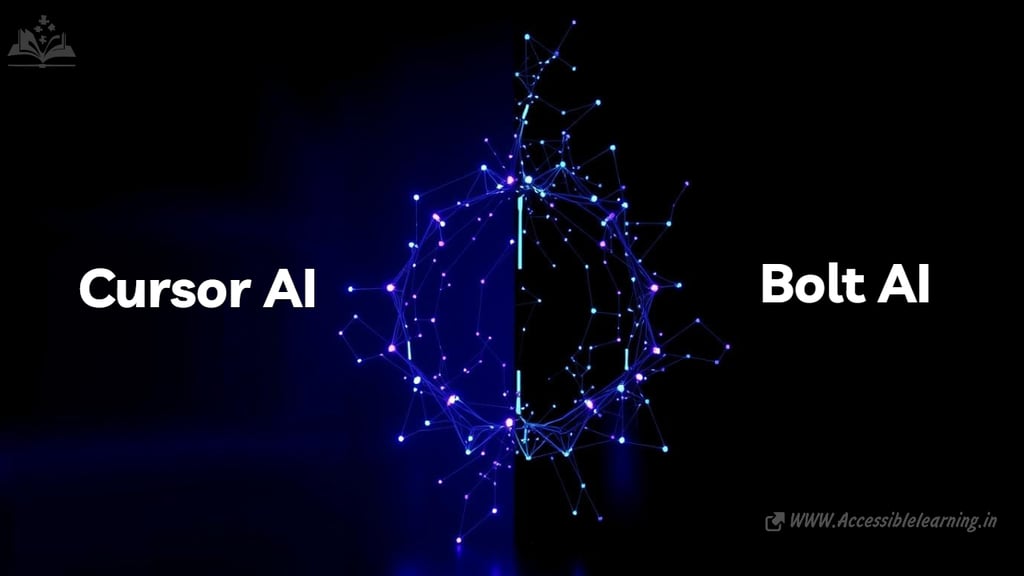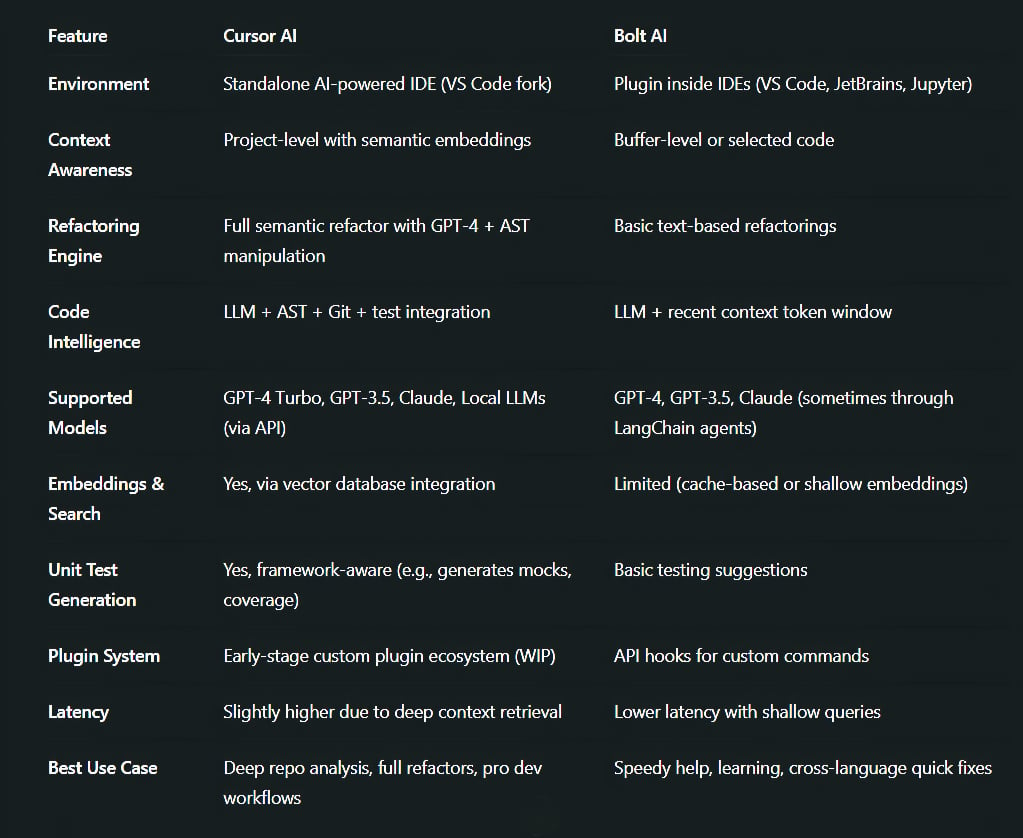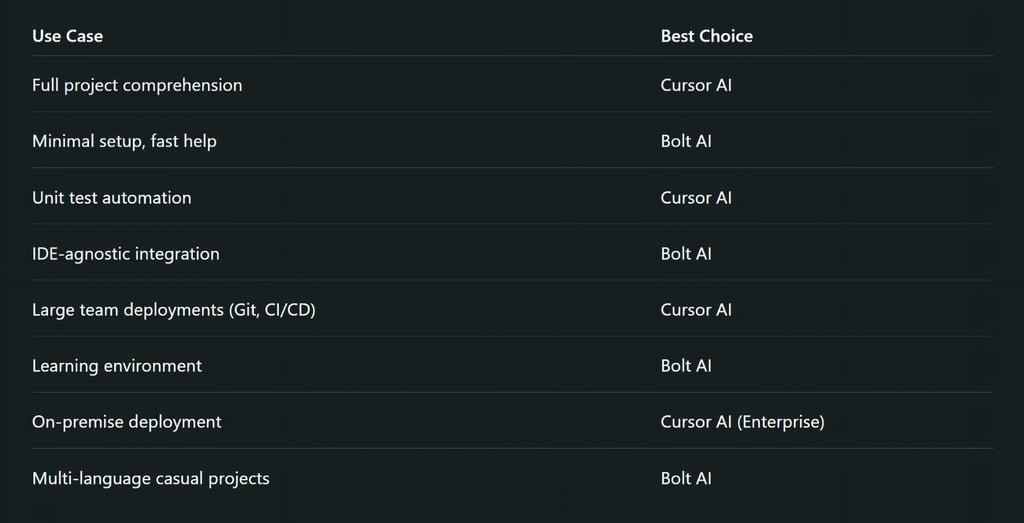
Cursor AI vs Bolt AI Comparison: IDE Integration, Refactoring, and AI Power Explained
Discover the in-depth technical comparison between Cursor AI and Bolt AI—two leading AI coding assistants. Explore their architecture, integration, developer workflows, performance, security, and use cases to choose the best tool for your coding needs.
AI ASSISTANTPROGRAMMINGAI/FUTURE
Sachin K Chaurasiya
4/29/20254 min read


As AI becomes an essential co-pilot for developers, choosing the right tool can significantly impact productivity, code quality, and team dynamics. Two standout contenders in the AI coding space are Cursor AI and Bolt AI. While both offer intelligent assistance, they differ in architecture, extensibility, model behavior, and depth of integration.
This article provides a technical and comprehensive breakdown of Cursor AI vs Bolt AI—designed for developers, engineering managers, and AI enthusiasts looking to choose their AI partner wisely.
What Is Cursor AI?
Cursor AI is a cutting-edge AI-powered code editor, forked from Visual Studio Code, and integrated directly with advanced models like GPT-4. It’s more than just a chat window bolted onto your IDE—it’s an intelligent partner that understands your code context, suggests real-time completions, and helps automate refactors, documentation, and testing.
Architecture & Integration
Cursor is a full IDE, forked from Microsoft’s Visual Studio Code but heavily optimized for LLM-assisted development. It runs as a desktop app and communicates with OpenAI’s API (or Anthropic’s Claude, depending on your configuration) through secure API calls, preserving local context.
It loads the entire project context into memory using custom token parsers, often leveraging vector databases (like Weaviate or Pinecone) for semantic search, allowing GPT-4 to reason with highly specific file or function-level context.
Key Features
Context-aware autocomplete based on the whole codebase.
Inline editing and refactoring using natural language.
Ask Cursor feature for intelligent Q&A within code.
Full Git integration to track changes and manage versions.
Test generation and explanation of complex functions.
Offline-friendly setup with on-premises options for enterprises.
Ideal For
Mid- to advanced-level developers.
Those working on complex, large-scale projects.
Teams that want a self-contained, AI-powered IDE.
Pricing
Free Plan: GPT-3.5, limited features.
Pro Plan: GPT-4, full context access, ~$20/month.
Enterprise: Custom pricing for offline usage and team support.
Codebase-Aware Interactions
Cursor leverages semantic embeddings to let you:
Chat with your entire codebase, even across multiple files and modules.
Perform cross-file refactoring using commands like “make this class async across the app.”
Generate and insert unit tests with mocking frameworks (e.g., Jest, Pytest) tailored to the architecture of your code.
Technical Highlights
Embedding Models: Uses OpenAI's text-embedding-ada-002 for vectorization.
Context Length: Up to 128K tokens with GPT-4 Turbo, allowing large monorepo reasoning.
Git Hooks: Cursor integrates tightly with Git to highlight changes, suggest commits, and write commit messages in conventional format.
Prompt Engineering Layer: Employs prompt chaining and prompt injection prevention.


What Is Bolt AI?
Bolt AI is an AI coding assistant designed to live inside your existing IDEs, such as VS Code, JetBrains, and even Jupyter Notebooks. Think of Bolt as a lightweight, plug-and-play assistant that provides context-aware code completions, explanations, and suggestions without forcing you to switch tools.
Architecture & Integration
Bolt AI is a plugin-first architecture that integrates into your existing environment, such as:
VS Code
IntelliJ / JetBrains
Jupyter Notebooks
It uses lightweight daemons or browser-based UIs to send real-time code snippets to AI APIs. Unlike Cursor, it does not fork the IDE, allowing smoother upgrades and less platform lock-in.
Bolt operates by capturing:
Function-level context
Recent buffer history
User prompts or selected text
It then forwards this information to models like GPT-4 or Claude through an agent-like framework that supports background tasks such as pre-fetching completions and summarizing past activity.
Key Features
Smart completions trained on large code datasets.
Multi-language support, including Python, JavaScript, Java, Go, etc.
Browser-based interface for quick accessibility.
Code documentation and learning tooltips.
Integrated chat assistant powered by GPT-style models.
Plugin-style setup works with existing IDEs.
Ideal For
Beginners and intermediate developers.
Freelancers and solo devs who want minimal setup.
Educators and learners who want code clarity and assistance.
Pricing
Free Tier: Available, but with limited completions.
Pro Plan: ~Starts around $10–15/month, depending on the provider.
Educational Discounts: Often available.
Technical Capabilities
Language Support: Supports over 30 languages, including Python, TypeScript, Java, Kotlin, Rust, and SQL.
Completion Engine: Inline suggestions (powered by server-side LLM inference) are presented as ghost text, similar to Copilot.
Docstrings & API Lookups: Generates docstrings compatible with NumPy, Google, and reST formats.
Token Efficiency: Optimizes payloads using sliding window tokenization to reduce latency in larger files.
Security: Uses ephemeral context tokens; sensitive data can be redacted before leaving the IDE.


Security & Privacy Considerations
Cursor AI supports self-hosted embeddings and local context servers for enterprise clients. Data can be kept on-premise with custom OpenAI API setups.
Bolt AI typically uses cloud-based inference, though recent updates allow integration with private endpoints (for businesses using Azure OpenAI or Anthropic via VPN).
Developer Ecosystem & Extensibility
Cursor AI: Offers early access to Cursor Plugins, letting teams script their own prompt sequences, automate PR reviews, or trigger CI/CD hooks via AI.
Bolt AI: Leverages a modular plugin engine where users can add tools like:
API call recorders
JSON-to-class converters
Code translators (e.g., Python → Go)
Future-Proofing: How They May Evolve
Cursor AI
Real-time agentic coding (autonomous file editing).
LLM-powered debugging through stack traces.
Team chat-to-code features.
Bolt AI
Unified memory across projects (like Ghostwriter).
Speech-to-code via Whisper integrations.
Support for RAG (Retrieval-Augmented Generation) to fetch project wiki/README data live.
If you're building enterprise-grade software, running multi-repo projects, or exploring DevOps automation with AI, Cursor AI is your powerhouse. It’s designed to embed intelligence deeply into your workflow.
But if you want something that “just works” inside your familiar IDE, gives fast completions, teaches best practices, and doesn’t overwhelm with features, Bolt AI is a great fit—especially for polyglot coders and learners.


Subscribe To Our Newsletter
All © Copyright reserved by Accessible-Learning Hub
| Terms & Conditions
Knowledge is power. Learn with Us. 📚


